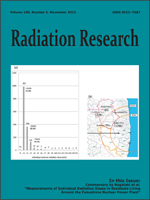It is unknown whether loss of skeletal muscle mass and function experienced by astronauts during space flight could be augmented by ionizing radiation (IR), such as low-dose high-charge and energy (HZE) particles or low-dose high-energy proton radiation. In the current study adult mice were irradiated whole-body with either a single dose of 15 cGy of 1 GeV/n 56Fe-particle or with a 90 cGy proton of 1 GeV/n proton particles. Both ionizing radiation types caused alterations in the skeletal muscle cytoplasmic Ca2 ([Ca2 ]i) homeostasis. 56Fe-particle irradiation also caused a reduction of depolarization-evoked Ca2 release from the sarcoplasmic reticulum (SR). The increase in the [Ca2 ]i was detected as early as 24 h after 56Fe-particle irradiation, while effects of proton irradiation were only evident at 72 h. In both instances [Ca2 ]i returned to baseline at day 7 after irradiation. All 56Fe-particle irradiated samples revealed a significant number of centrally localized nuclei, a histologic manifestation of regenerating muscle, 7 days after irradiation. Neither unirradiated control or proton-irradiated samples exhibited such a phenotype. Protein analysis revealed significant increase in the phosphorylation of Akt, Erk1/2 and rpS6k on day 7 in 56Fe-particle irradiated skeletal muscle, but not proton or unirradiated skeletal muscle, suggesting activation of pro-survival signaling. Our findings suggest that a single low-dose 56Fe-particle or proton exposure is sufficient to affect Ca2 homeostasis in skeletal muscle. However, only 56Fe-particle irradiation led to the appearance of central nuclei and activation of pro-survival pathways, suggesting an ongoing muscle damage/recovery process.
How to translate text using browser tools
17 October 2013
Divergent Modification of Low-Dose 56Fe-Particle and Proton Radiation on Skeletal Muscle
Alexander Shtifman,
Matthew J. Pezone,
Sharath P. Sasi,
Akhil Agarwal,
Hannah Gee,
Jin Song,
Aleksandr Perepletchikov,
Xinhua Yan,
Raj Kishore,
David A. Goukassian
ACCESS THE FULL ARTICLE

Radiation Research
Vol. 180 • No. 5
November 2013
Vol. 180 • No. 5
November 2013




